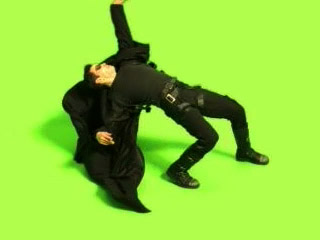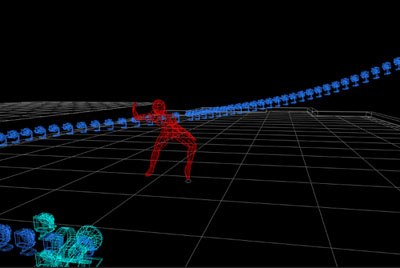
RECONSTRUCTION:THE DOCTOR WHO PROJECT II

RECONSTRUCTION:THE DOCTOR WHO PROJECT II
IS THIS THE WAY FORWARD?
THIS WAS PHASE ONE IN APRIL: THE IDEA I PRESENTED TO THE WORLD THAT HAS LEAD TO THE NEXT STAGE OF THE PROJECT.
PLEASE NOTE THAT SINCE THIS WAS POSTED, THE IDEA HAS MOVED ON, AND SADLY, BULLET-TIME RENDERING HAS NOT PROVED A REALISTIC IDEA... YET...
PHASE ONE: APRIL/MAY 2000:
This is what the Site is really here for...
The core idea for the Doctor Who Project began with the computer technology developed for the 1999 Warner Bros. movie, "The Matrix". Below follows a brief background to this technology, and how it works...
Note: The following dialogue and pictures are availble at the official Matrix website (http://whatisthematrix.com).
Capturing the Action: Bullet-Time Photography Super slow motion would be relied on heavily in the stylization of the action scenes in "The Matrix," but certain moments in the script called for something special. These scenes required dynamic camera movement around slow-motion events that approached 12,000 frames per second. The Wachowskis called it "bullet-time photography."
This "Flow-Mo" process allows filmmakers almost unlimited flexibility in controlling the speed and movement of on-screen elements. For example, a fighter leaping into the air to kick his opponent could accelerate to the apex of his leap, appear to hover in the air, extend his leg in a lightening-fast movement, and then gently descend to the ground. Joel Silver describes the process as similar to "full-cel animation, only with people." The Wachowskis met with JOHN GAETA, the visual-effects director at Manex, a visual-effects facility in Northern California, to discuss their goals. Says Gaeta, "The Wachowskis are from the comic-book culture, and are therefore familiar with the Japanese animation style called anime, which we re-created with live actors for this movie. Anime takes advantage of 'the physics of decimation' it breaks down action into its components and allows those elements to be meticulously controlled to build the most dramatic effect from dynamic movement."

Gaeta's team and the filmmakers first blocked out the action that was going to be rendered and filmed the scene using conventional cameras. Then they scanned the images into a computer and, using a laser-guided tracking system, "mapped out" the movements of the camera that would capture the final scene. A series of sophisticated still cameras was placed along the mapped path, each of which would shoot a single still photo. Then the photos were scanned into the computer, which created a strip of still images, similar to animation cels. The computer generated "in-between" drawings of the images much as animators draw frames to move their characters smoothly from one pose to another and the completed series of images could be passed before the viewers' eyes as quickly or slowly as the filmmakers wanted without losing clarity.

Obviously, this painstaking technique takes time and precision, but it renders moving objects and people in a completely new way. Says Joel Silver, "Itšs like the Japanese films "Ghost in the Shell" or "Akira" but ours is a real-life film depiction of anime, whereas those are animated films. Wešve used every kind of visual effect utilized before and taken each one step further."
So, basically, the computer was taking a series of timed 2-D photographs, and adding a third dimension to it, making it look like it had be shot on a 35MM film camera, when really, the software is animating photos as if it were film.